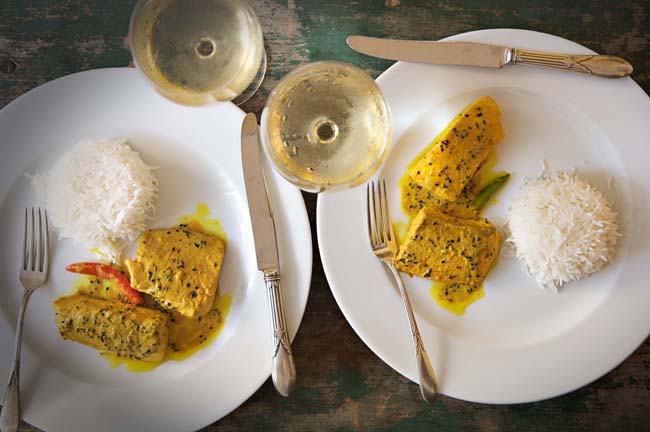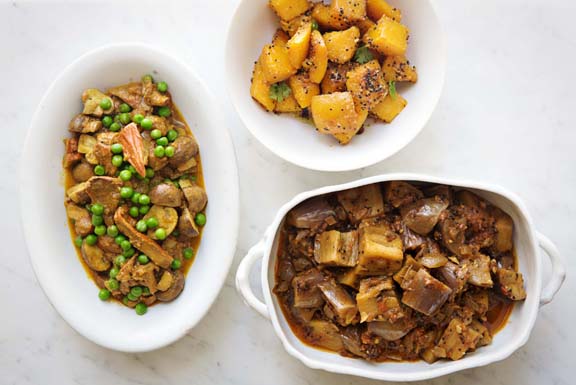
Recipes from Madhur Jaffrey
Salmon in a Bengali Mustard Sauce
Eat this with plain rice and make the sauce as hot as you like. In Bengal, the mustard seeds are ground at home, but to make matters simpler I have used commercial ground mustard, also sold as mustard powder. You may also use halibut instead of the
salmon. This very traditional dish is best served with Plain Basmati Rice, along with My Everyday Moong Dal, if you like, and a green vegetable. serves 2–3
To rub on the fish:
3/4 pound skinless salmon fillet
1/4 teaspoon salt
1/4 teaspoon ground turmeric
1/4 teaspoon cayenne pepper
You also need:
1 tablespoon ground mustard
¼-1/2 teaspoon cayenne pepper
1/4 teaspoon ground turmeric
1/4 teaspoon salt
2 tablespoons mustard oil (use extra virgin olive oil as a substitute)
1/4 teaspoon whole brown mustard seeds
1/4 teaspoon whole cumin seeds
1/4 teaspoon whole fennel seeds
2 fresh hot green and/or red chilies (bird’s-eye is best), slit slightly
Cut the fish into pieces that are about 2″ x 1″ and rub them evenly with the salt, turmeric, and cayenne. Cover and set aside in the refrigerator for 30 minutes–10 hours. Put the mustard powder, cayenne, turmeric, and salt in a small bowl. Add 1 tablespoon water and mix thoroughly. Add another 7 tablespoons water and mix. Set aside.
Pour the oil into a medium frying pan and set over medium-high heat. When hot, put in the mustard seeds. As soon as they start to pop, a matter of seconds, add the cumin and fennel seeds. Stir once and quickly pour in the mustard paste. Add the green chilies, stir, and bring to a gentle simmer. Place the fish pieces in the sauce in a single layer. Simmer gently for about 5 minutes, or until the fish is just cooked through, spooning the sauce over the fish all the time.

Eggplants in a North-South Sauce
This is one of our most beloved family dishes. It is very much in the Hyderabadi style, where North Indian and South Indian seasonings are combined. Over the years, I have simplified the recipe. Here, you may use the long, tender Japanese eggplants or the purple “baby” Italian eggplants or even the striated purple and white ones that are about the same size as the baby Italian ones. Once cut, what you are aiming for are 1-inch chunks with as much skin on them as possible so they do not fall apart.
Serve this hot with meat or vegetable curries, rice, and dal or serve it cold, as a salad, with cold meats, Indian (see Chicken Karhai with Mint) or Western. I love it with slices of ham. serves 4–6
4 tablespoons olive or canola oil
1/8 teaspoon ground asafetida
1/2 teaspoon skinned urad dal or yellow split peas
1/2 teaspoon whole mustard seeds
1/2 teaspoon whole cumin seeds
1/2 teaspoon whole nigella seeds (kalonji)
1/2 teaspoon whole fennel seeds
1 medium onion, chopped
2 cloves garlic, chopped
1.5 pounds slim Japanese eggplants, cut crossways into 1-inch segments, or “baby” Italian eggplants cut in half lengthways and then crossways, into 1-inch segments
2 medium tomatoes, grated (see page 289), about 1.25 cups
1 cup chicken stock or water
1 teaspoon salt
¼-1/2 teaspoon cayenne pepper
Pour the oil into a very large frying pan and set over medium-high heat. When hot, put in the asafetida and the urad dal. As soon as the dal turns a shade darker, add the mustard, cumin, nigella, and fennel seeds, in that order. When the mustard seeds begin to pop, a matter of seconds, add the onions. Stir and fry for a minute. Add the garlic and the eggplant. Stir and fry for 4–5 minutes or until the onions are a bit browned. Add the grated tomatoes, stock, salt, and cayenne. Stir to mix and bring to a boil. Cover, turn heat to low, and cook about 20 minutes or until the eggplants are tender, stirring now and then.
Rice Pilaf with Almonds and Raisins
Pilafs may be served at everyday meals but are grand enough for entertaining as well. If you like, you could add a generous pinch of saffron threads to the rice just before you cover it and let it simmer. You could also use chicken stock instead of the 22 cup water. serves 4–6
2 cups basmati rice
3 tablespoons olive or canola oil or ghee
One 2-inch cinnamon stick
1/2 medium onion, sliced into fine half Rings
2 tablespoons slivered blanched almonds
2 tablespoons golden raisins
1 teaspoon salt
Put the rice in a bowl. Wash in several changes of water. Drain. Let the rice soak in water that covers it generously for 30 minutes. Drain through a sieve and leave in the sieve suspended over a bowl to drip. Pour the oil into a heavy, medium pan (that has a tight-fitting lid) and set over medium-high heat. When hot, put in the cinnamon. Let it sizzle for 10 seconds. Put in the onions. Stir and fry the onions until they start to brown. Add the almonds. Stir until they are golden. Add the raisins. Stir until they are plump, just a few seconds. Add the drained rice and salt. Stir very gently to mix. Add 2 2/3 cups water and bring to a boil. Cover tightly, turn heat to very, very low, and simmer gently for 25 minutes
(Excerpted from At Home with Madhur Jaffrey by Madhur Jaffrey Copyright © 2010 by Madhur Jaffrey. Excerpted by permission of Knopf, a division of Random House, Inc. All rights reserved. No part of this excerpt may be reproduced or reprinted without permission in writing from the publisher.)
Related Article: At Home with Madhur Jaffrey
Related Article: Madhur Jaffrey – Mistress of Spices

7 Comments
Amishi, sorry for the late response! If I don’t do it immediately I get totally engrossed in other things. Her books are a must for a shelf on Indian cooking, and also Far Eastern recipes. I loved ‘Climbing the Mango Trees’ too for it reminded me of my Delhi childhood too. As for ginger, it’s a must for me in cauliflower – it really enhances the taste.
I got the book ‘At Home with Madhur Jaffrey’ last month. Loved the photographs and descriptions at the start of every section. My husband and I tried the Baked Chicken Curry from that book. And it tasted great, especially with rice. Am yet to try other decadent dishes. Her books are easy to understand and the photographs make you want to try the recipes. I’d read her book, ‘Climbing the Mango Trees’ a long time back. It reminded me of my childhood days in India. I read her recipe of Everyday Aloo Gobi in that book. Ever since, have been putting ginger in my cauliflower sabji!
Lavina, I just lent my copy to a friend so, I just ogled it for now…but would like to try it as well…:)
look forward to reading about Madhur’s film career….
Hi Nivi, have you made the salmon curry yet or just ogled it? I generally tend to satisfy myself by looking at all the great food images but some Madhur Jaffrey dishes have become standards in our home.
Nivi, I’ll take you up on the suggestion and do a piece in the new year on her films.
Hi Geetika,
I’ve followed Madhur Jaffrey’s career through the years and you are so right. She’s very special, both in her profession and as a person. To that I would add, wonderful actor too!
I bought her book, first thing that caught my eye in that book was salmon curry….yum
I am waiting for an opportunity to personally meet her…hope some day…
Lavina, please interview her about her movies. She is simply delicious as an actress and loved watching all her movies…:))
thank you
Nivi
Madhur Jaffrey is a fantastic cookbook author as well as a marvelous person.
I saw her demonstrating some of the recipes that you have here and I learn something from her each time.